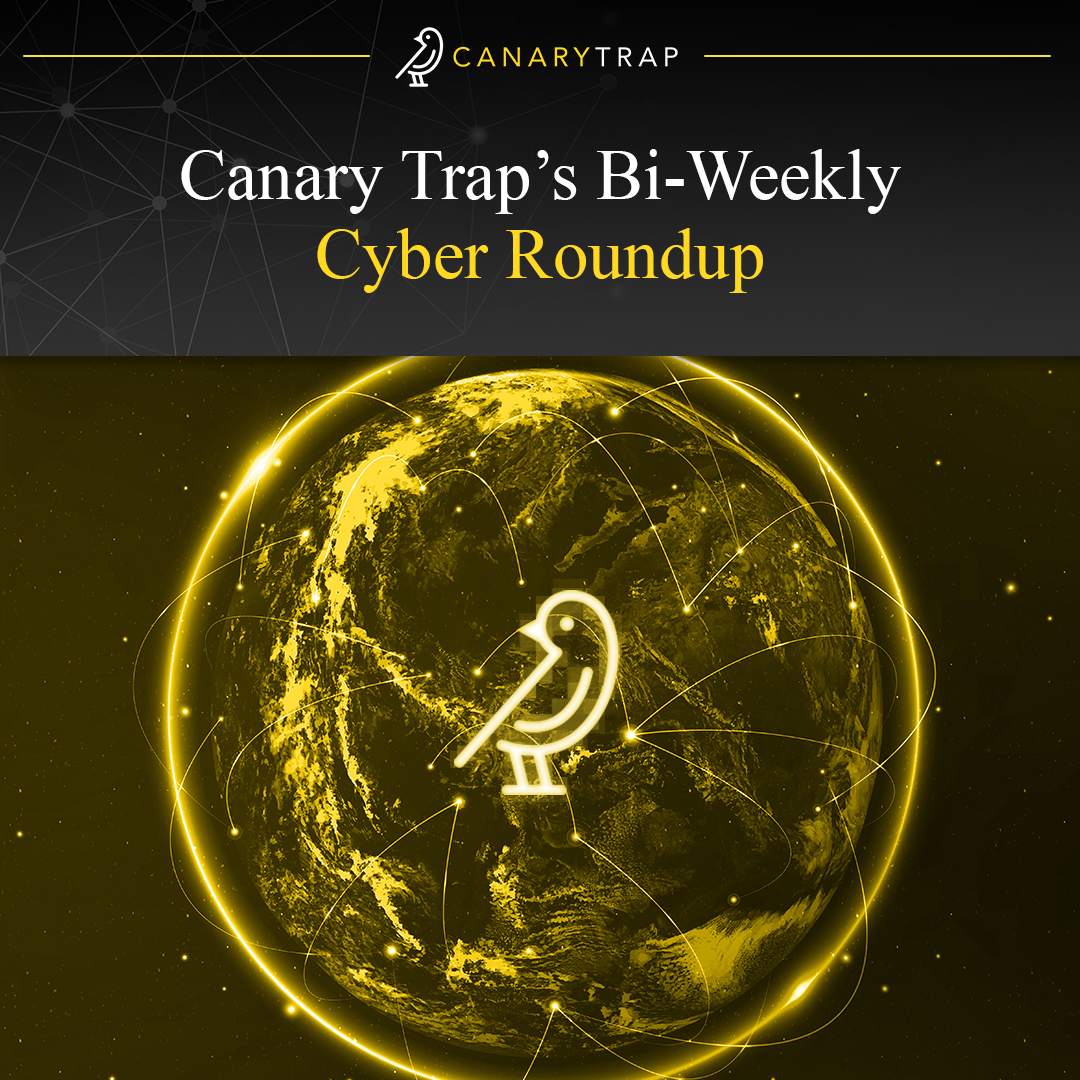Canary Trap’s Bi-Weekly Cyber Roundup
Welcome to this month’s edition of the “Bi-Weekly Cyber Roundup” by Canary Trap. In this ever-evolving landscape of cybersecurity, staying informed is not just a choice, but a necessity. Our mission is to keep you up-to-date with the most critical developments in the digital defense realm, and this bi-weekly publication is your gateway to the latest news. In this edition of the roundup, we’ll dive into an array of headlines that underscore the dynamic nature of cybersecurity. From ‘The US Government Shares Cyber Attack Defense Tips for Water Utilities’ to ‘Ransomware Trends and Projections’, we’re here to dissect the significant events shaping the digital world’s safety.
You’ll also read about some new Wi-Fi Vulnerabilities, which expose devices to cyber threats, Apple enhancing the security of iMessage with Post-Quantum Encryption, and the US searching for information regarding the LockBit Ransomware Gang, by putting out a bounty of $15 Million for Information connected to the Gang. With the “Bi-Weekly Cyber Roundup,” we aim to equip you with the knowledge and insights necessary to navigate this ever-changing landscape.
- US Government Shares Cyber Attack Defense Tips for Water Utilities
In the wake of escalating cyber threats targeting critical infrastructure, the US government has taken proactive measures to enhance cybersecurity within the water utilities sector. Recognizing the vital role that water utilities play in society, the government has released comprehensive cybersecurity guidance aimed at fortifying defenses against potential cyber attacks.
Water utilities are increasingly becoming targets of cybercriminals seeking to exploit vulnerabilities in critical infrastructure systems. A successful cyber attack on a water utility could have devastating consequences, potentially disrupting the supply of clean and safe water to communities and posing significant risks to public health and safety.
The cybersecurity guidance provided by the US government offers practical recommendations for water utilities to bolster their security posture and mitigate the risk of cyber attacks. These recommendations include implementing robust access controls, regularly updating software and systems, conducting thorough risk assessments, and establishing incident response protocols.
One of the key recommendations outlined in the guidance is the importance of network segmentation, which involves dividing a network into smaller, isolated segments to prevent lateral movement by cyber attackers. By segmenting their networks, water utilities can limit the scope of potential cyber attacks and minimize the impact on critical operations.
Furthermore, the guidance emphasizes the critical role of employee training and awareness in defending against cyber threats. Educating staff members about phishing scams, social engineering tactics, and other common attack vectors can help mitigate the risk of human error leading to security breaches.
In addition to the cybersecurity guidance, the US government is also working closely with water utilities to enhance information sharing and collaboration on cyber threat intelligence. By fostering a collaborative cybersecurity ecosystem, stakeholders can better detect, respond to, and mitigate cyber threats in real-time.
Overall, the US government’s initiative to share cyber attack defense tips for water utilities underscores the importance of cybersecurity in safeguarding critical infrastructure. By implementing the recommended security measures and fostering a culture of cyber resilience, water utilities can better protect their systems and ensure the continued delivery of essential services to communities across the country.
- Cyber Insights for 2024: Ransomware Trends and Projections
As the threat landscape continues to evolve, security experts are offering valuable insights into the future of ransomware attacks in 2024. Ransomware, a form of malware that encrypts files and demands payment for their release, has emerged as one of the most pervasive and damaging cyber threats facing organizations worldwide.
In the coming year, security researchers anticipate several key trends and developments in the ransomware landscape. One of the most notable trends is the rise of double extortion schemes, where cybercriminals not only encrypt data but also threaten to release it publicly unless a ransom is paid. This tactic puts additional pressure on victims to comply with ransom demands, as the exposure of sensitive information can result in reputational damage and regulatory consequences.
Furthermore, ransomware attacks are expected to increasingly target critical infrastructure sectors, including healthcare, energy, and transportation. These sectors are particularly vulnerable to ransomware attacks due to their reliance on interconnected systems and the potential impact on public safety and national security.
To combat the growing threat of ransomware, organizations must adopt a proactive approach to cybersecurity. This includes implementing robust backup and recovery solutions, conducting regular security assessments, and enhancing employee training and awareness programs. By investing in cybersecurity measures, organizations can better defend against ransomware attacks and minimize the impact on their operations.
In addition to technical defenses, collaboration and information sharing are essential components of a comprehensive ransomware defense strategy. By sharing threat intelligence and best practices with industry peers and law enforcement agencies, organizations can gain valuable insights into emerging threats and enhance their collective resilience against ransomware attacks.
Overall, the insights into ransomware trends and projections for 2024 serve as a stark reminder of the ongoing threat posed by cybercriminals. By staying informed about the latest developments and adopting proactive security measures, organizations can better protect themselves against ransomware attacks and safeguard their critical assets and data.
- New Wi-Fi Vulnerabilities Expose Devices to Cyber Threats
In a digital landscape increasingly reliant on wireless connectivity, the discovery of new Wi-Fi vulnerabilities serves as a stark reminder of the ongoing battle against cyber threats. These vulnerabilities, uncovered by security researchers, have the potential to expose connected devices to various risks, including man-in-the-middle attacks, data interception, and unauthorized access.
The implications of these vulnerabilities are significant, as they could compromise sensitive information, disrupt network operations, and enable threat actors to launch further cyber attacks. Organizations and individuals must take proactive measures to mitigate these risks and safeguard their wireless networks against exploitation.
To address these vulnerabilities effectively, organizations should prioritize the implementation of robust Wi-Fi security measures. This includes adopting encryption protocols such as WPA3, implementing strong authentication mechanisms, and segmenting Wi-Fi networks to isolate sensitive data and critical systems.
In addition to technical defenses, ongoing monitoring and vulnerability scanning of Wi-Fi networks are essential to identify and address security weaknesses proactively. By staying vigilant and responsive to emerging threats, organizations can enhance their resilience against Wi-Fi vulnerabilities and protect their digital assets from exploitation.
Overall, the discovery of new Wi-Fi vulnerabilities underscores the importance of continuous security efforts in an ever-evolving threat landscape. By staying informed about the latest developments and implementing best practices for Wi-Fi security, organizations and individuals can mitigate the risks posed by these vulnerabilities and maintain the integrity of their wireless networks.
- US Offers $15 Million Bounty for Info on LockBit Ransomware Gang
In a bold move to combat ransomware threats, the US government has announced a substantial bounty for information leading to the identification of the LockBit ransomware gang. LockBit, a notorious cybercriminal group, has gained notoriety for its sophisticated ransomware-as-a-service model, which enables affiliates to deploy ransomware attacks on behalf of the gang in exchange for a share of the ransom payments.
The decision to offer a $15 million bounty reflects the severity of ransomware threats and the government’s commitment to holding cybercriminals accountable for their actions. By targeting the LockBit gang, authorities aim to disrupt their operations and dismantle their infrastructure, thereby reducing the prevalence and impact of ransomware attacks on businesses and individuals.
The bounty serves as a powerful incentive for individuals with knowledge of the gang’s activities to come forward and assist law enforcement agencies in their investigations. By collaborating with international partners and leveraging actionable intelligence, authorities can strengthen their efforts to combat ransomware and protect critical infrastructure from cyber threats.
In addition to law enforcement actions, organizations must also take proactive measures to defend against ransomware attacks. This includes implementing robust cybersecurity measures, conducting regular security assessments, and enhancing employee training and awareness programs. By adopting a multi-layered approach to ransomware defense, organizations can minimize the risk of falling victim to ransomware attacks and mitigate the impact on their operations.
Overall, the US government’s decision to offer a bounty for information on the LockBit ransomware gang underscores the seriousness with which authorities are addressing the ransomware threat. By working together to combat ransomware and disrupt cybercriminal operations, governments and organizations can better protect themselves against this pervasive and damaging cyber threat.
- Apple Adds Post-Quantum Encryption to iMessage
In a move to enhance user privacy and data security, Apple has announced the addition of post-quantum encryption to iMessage, its popular messaging platform. Post-quantum encryption algorithms are designed to withstand attacks from quantum computers, which have the potential to undermine traditional cryptographic methods.
By implementing post-quantum encryption in iMessage, Apple aims to ensure that user communications remain secure against future threats posed by quantum computing advancements. The deployment of end-to-end encryption (E2EE) and forward secrecy further enhances the confidentiality and integrity of iMessage communications, preventing unauthorized access and eavesdropping by third parties.
The decision to integrate post-quantum encryption into iMessage underscores Apple’s commitment to prioritizing user privacy and staying ahead of emerging cybersecurity risks. By leveraging advanced cryptographic techniques and adhering to industry best practices, Apple enhances the security of its products and protects user data from evolving cyber threats effectively.
In addition to technical defenses, user education and awareness play a crucial role in maintaining security and privacy online. By educating users about the importance of strong encryption and secure communication practices, Apple empowers its users to take control of their digital privacy and protect their sensitive information from unauthorized access.
Overall, Apple’s integration of post-quantum encryption into iMessage represents a significant advancement in the field of digital security. By leveraging cutting-edge encryption technologies and prioritizing user privacy, Apple continues to set the standard for secure communication platforms in an increasingly interconnected world.
Staying informed about cybersecurity developments is essential for navigating the ever-changing threat landscape effectively. By leveraging insights from recent news articles and adopting advanced security measures, everyone can strengthen their defenses and mitigate cyber risks effectively.
SOURCES:
- https://www.bleepingcomputer.com/news/security/us-govt-shares-cyberattack-defense-tips-for-water-utilities/
- https://www.securityweek.com/cyber-insights-2024-ransomware/
- https://thehackernews.com/2024/02/new-wi-fi-vulnerabilities-expose.html
- https://www.bleepingcomputer.com/news/security/us-offers-15-million-bounty-for-info-on-lockbit-ransomware-gang/
- https://www.securityweek.com/apple-adds-post-quantum-encryption-to-imessage/

